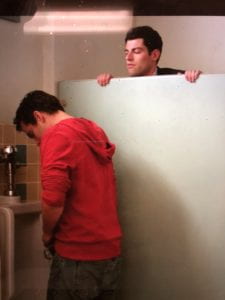Work Cited
Peer Reviewed
Berg, Leah R. Vande and Diane Streckfuss. “Prime-Time Television’s Portrayal of Women and the World of Work: A Demographic Profile.” Journal of Broadcasting & Electronic Media, vol. 36, no. 2, Spring92, p. 195. EBSCOhost, prx.library.gatech.edu/login?url=http://search.ebscohost.com/login.aspx?direct=true&db=a9h&AN=9208170546&site=ehost-live.
“Prime-Time Television’s Portrayal of Women and the World of Work: A Demographic Profile.” analyses prime-time shows and their respective representation of women in the working world. Indicates that women in television are underrepresented and forced into limited possible occupations. Women are also typically shown as performing more interpersonal actions whereas men are shown as working in political and decisive positions.
This article will be useful in the fact that it defines the type of jobs that women are typically limited to and help to further identify potential stereotypical occupations. The results revealed in this study will be used specifically as support for the idea that Women’s occupational roles in television are not accurate of societal norms since this article directly compares popular television representations to actual industry statistics. Further, this article will provide numerical data for the ideas of women being underrepresented in television due to it’s largely quantitative set of statistics provided throughout the article.
Peer Reviewed
Gregori-Signes, Carmen. “”Apparently, Women Don’t Know how to Operate Doors”: A Corpus-Based Analysis of Women Stereotypes in the TV Series 3rd Rock from the Sun.” International Journal of English Studies, vol. 17, no. 2, 2017, pp. 21-43. ProQuest, http://prx.library.gatech.edu/login?url=https://search.proquest.com/docview/1977738284?accountid=11107, doi:http://dx.doi.org/10.6018/ijes/2017/2/257311.
“Apparently, Women Don’t Know how to Operate Doors” analyses the portrayal of women and their roles (including occupations) in the American sitcom “3rd Rock from the Sun”. The article focuses on the reliance of the writers on using stereotypes regarding women as a constant source for humor. The data provided in the article is both qualitative and quantitative providing many examples from which one could draw.
This article is imperative to the research being conducted since it is specific to female portrayal in an American sitcom. Although occupational portrayal is not the main focus, it is part of the spectrum of which the author of the article examines stereotype enforcement. This article will also be a helpful source due to the large amount of examples the author provides from “3rd Rock from the Sun”. These examples will be used to compare television portrayals to societal actualities which will eventually provide evidence towards an answer for the overall question regarding female occupations in television as compared to reality.
Peer Reviewed
Lacalle, Charo, and Beatriz Gómez. “The Representation of Workingwomen in Spanish Television Fiction/La Representación De Las Mujeres Trabajadoras En La Ficción Televisiva Española.” Comunicar, vol. 24, no. 47, 2016, pp. 59-67. ProQuest, http://prx.library.gatech.edu/login?url=https://search.proquest.com/docview/1781327887?accountid=11107, doi:http://dx.doi.org/10.3916/C47-2016-06.
“The Representation of Workingwomen in Spanish Television Fiction” is an article that examines 709 female characters in fictional spanish programs. This project uses both quantitative and qualitative methods to analyze the roles in the show of female characters including their occupation. Results of the study showed that many female characters remain in stereotypical situations being caregivers or members of customer service, whereas other female characters are shown as skilled professionals. Subsequently, the female characters shown in non-traditional roles are often associated with negative representations of the character.
This paper is crucial to investigating the at hand topic by providing evidence and examples for female characters locked into traditional occupations. Also, this paper is interesting in the way in which is shows the “connection” the exists between traditional roles and positive representation by exhibiting female characters of power who are associated with the negative aspects of the story. Although this source is not exclusively regarding sitcoms it still remains important since it includes examples from spanish comedies (sitcoms).
Peer Reviewed
Lippa, Richard A., et al. “Women’s Representation in 60 Occupations from 1972 to 2010: More Women in High-Status Jobs, Few Women in Things-Oriented Jobs.” PLoS ONE, vol. 9, no. 5, May 2014, pp. 1–8. EBSCOhost, doi:10.1371/journal.pone.0095960.
“Women’s Representation in 60 Occupations from 1972 to 2010: More Women in High-Status Jobs, Few Women in Things-Oriented Jobs.” explores trends in 60 occupations over a course of 38 years to see the growing representation of women in the working world. The study separated occupations into categories by status, people-things orientation, and data-ideas orientation. Results showed that women are increasingly entering occupations of high status, but their participation in thing oriented jobs (mechanics, construction, etc) remained low and unchanged throughout the years. The article uses evidence to compare sex segregation theories and stereotypes to reality.
This article will be crucial to research since it will be used as a representation of reality. Unlike other sources, the focus of this paper lies on statistics regarding the working world rather than television. All data and research into television will be compared and contrasted to this source to assist with the papers conclusion.
Peer Reviewed
McCauley, Clark, et al. “Sex Stereotyping of Occupations in Relation to Television Representations and Census Facts.” Basic & Applied Social Psychology, vol. 9, no. 3, Sept. 1988, pp. 197-212. EBSCOhost, prx.library.gatech.edu/login?url=http://search.ebscohost.com/login.aspx?direct=true&db=a9h&AN=7301410&site=ehost-live.
The source “Sex Stereotyping of Occupations in Relation to Television Representations and Census Facts.” examines the effects of television on the distortion of social views regarding gender stereotypes of occupations. This is done by surveying high schoolers, college students, and train passengers on their estimates regarding the demographic of commonly stereotyped occupational fields. These results were then compared to U.S. Census Data and gender portrayals on television. Results showed that television was not responsible for the distortion of the perception of reality since the participants overestimated gender equality in occupations.
The value of this source lies in the fact that it was conducted in a scientific manner giving it empirical significance, and that the results undermine the popular belief that television changes social perception on gender in the working world. The topic at hand is the portrayal of Women’s occupations in sitcoms, and what this article provides is a context for the importance of the topic. This article actually discredits the topic by saying that portrayal on television doesn’t affect personal beliefs. This paper will be used as a counterpoint and as a source of data on the topic.
Peer Reviewed
Paek, Hye-jin, Michelle R. Nelson, and Alexandra M. Vilela. “Examination of Gender-Role Portrayals in Television Advertising Across Seven Countries.” Sex Roles, vol. 64, no. 3-4, 2011, pp. 192-207. ProQuest, http://prx.library.gatech.edu/login?url=https://search.proquest.com/docview/850508440?accountid=11107, doi:http://dx.doi.org/10.1007/s11199-010-9850-y.
The study “Examination of Gender-Role Portrayals in Television Advertising Across Seven Countries.” is a meta analysis of 2,608 commercials looking at the uses of men and women in different situations. The paper finds that women are typically portrayed as the product user, being dependent on others and often found at home. This paper then looks at how these portrayals correlate to common stereotypes relating to gender.
Even though the focus of this paper lies in commercials it remains relevant because it lays a groundwork for the cause and effect relationship between television representation and the propagation of stereotypes in society. The information provided in this article can be used to define portrayals that may or may not be stereotypical, as well as how to examine the impact this has on society. Also this information gives a cross cultural base from which the question at hand may be answered since it originates from 7 countries.


















